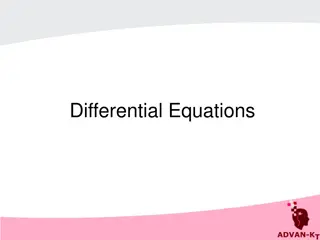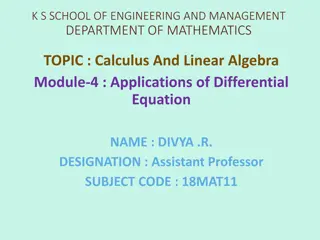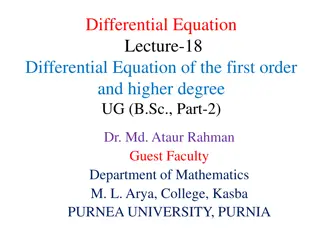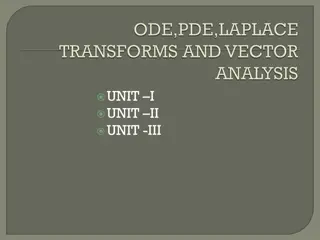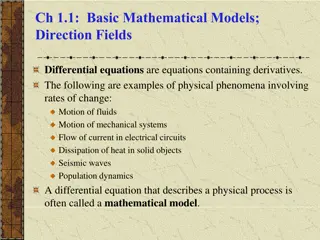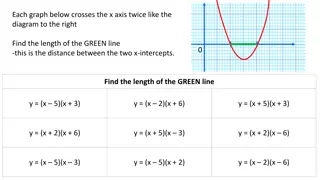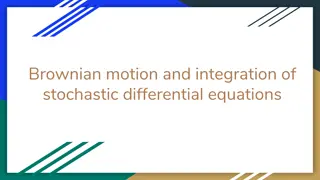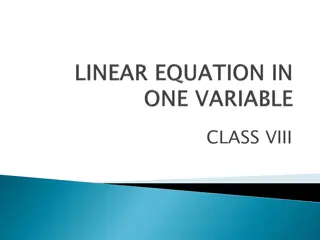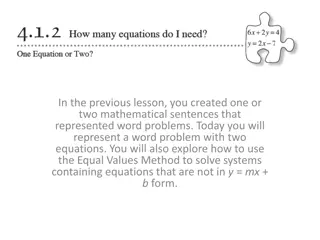Understanding Differential Equations and Boundary Value Problems
Explore the world of Differential Equations (DE) with a focus on Boundary Value Problems, guided by Dennis G. Zill and Michael R. Cullen. Dive into the realm of First Order and Higher Order DE, Partial DE, Laplace Transform, Fourier Series, and more. Unravel the complexities of DE through various sections, definitions, notations, and applications outlined in this comprehensive course. Stay organized with the course schedule detailing important dates for homework, midterms, and finals.
Download Presentation

Please find below an Image/Link to download the presentation.
The content on the website is provided AS IS for your information and personal use only. It may not be sold, licensed, or shared on other websites without obtaining consent from the author. Download presentation by click this link. If you encounter any issues during the download, it is possible that the publisher has removed the file from their server.
E N D
Presentation Transcript
1 -- Differential Equations (DE) http://djj.ee.ntu.edu.tw/DE.htm ( )
2 3, 4 (AM 10:20~12:10) 205 ( NTUCool) "Differential Equations-with Boundary-Value Problem," Dennis G. Zill and Michael R. Cullen, 9thedition, 2017. (metric version, international version) 15%, 42.5%, 42.5%
3 Office 723 , TEL 33669652 Office hour E-mail: jjding@ntu.edu.tw http://djj.ee.ntu.edu.tw/DE.htm http://disp.ee.ntu.edu.tw/ http://cc.ee.ntu.edu.tw/~tomme/DE/DE.html shengyang@ntu.edu.tw
4 (1) NTUCool (2) http://djj.ee.ntu.edu.tw/DE.htm (3) (4) 40%~90% (5) 11
5 Week Number Date (Wednesday) Remark 1. 9/4 2. 9/11 3. 9/18 4. 9/25: HW1 5. 10/2 6. 10/9 7. 10/16: HW2 8. (Sections 2-2 ~ 4-5) 10/23: Midterms 9. 10/30 10. 11/6 11. 11/13 12. 11/20: HW3 13. 11/27 14. 12/4 15. 12/11: HW4 16. 12/18: Finals (Sections 4-6 ~ 12-4)
6 Introduction (Chap. 1) (Chap. 2) (Chap. 3) First Order DE (Chap. 8 ) (Chap. 4) (Chap. 5 ) Higher Order DE (Sections 4-10, 5-3, ) (Chap. 6) (Sections 12-1, 12-4) (Chapter 12 ) (Chapter 13 ) Partial DE Laplace Transform (Chap. 7 ) Fourier Series (Chap. 11) Transforms Fourier Transform (Chap. 14 )
7 Sections 1-1, 1-2, 1-3 Sections 2-1, 2-2, 2-3, 2-4, 2-5, 2-6 Sections 3-1, 3-2 Sections 4-1, 4-2, 4-3, 4-4, 4-5 Sections 4-6, 4-7 Sections 6-1, 6-2, 6-3, 6-4 Sections 11-1, 11-2, 11-3 Sections 12-1, 12-4 blue colors:
8 Chapter 1 Introduction to Differential Equations 1.1 Definitions and Terminology ( ) (1)Differential Equation (DE): any equation containing derivation (text page 3, definition 1.1) (2) x: independent variable ( ) dy x = 1 y(x): dependent variable dx 3 ( ) d f x dx x ( ) x + = sin( ) ( t f x t dt ) cos 3 0
9 Note: In the text book, f(x) is often simplified as f notations of differentiation 3 4 2 d f dx d f dx d f dx df dx 3 4 2 , , , , . Leibniz notation , , , , . prime notation f f f f (4) , , , , . dot notation f f f f xxx f xxxx f f xf , , , , . subscript notation xx
10 (3) Ordinary Differential Equation (ODE): differentiation with respect to one independent variable 3 2 dx dt dy dt dz dt d u dx d u dx du dx + + = + + + + = 2 xy z cos(6 ) 0 x u 3 2 (4) Partial Differential Equation (PDE): differentiation with respect to two or more independent variables 2 2 u u x t y + = 0 = 2 2 x y
11 (5) Order of a Differentiation Equation: the order of the highest derivative in the equation 7 6 5 4 d u dx d u dx d u dx d u dx 7thorder + + + = 2 2 4 0 7 6 5 4 2 d y dx dy dx 2ndorder + = x 4 5 y e 2
12 (6) Linear Differentiation Equation: ( ) ( ) 1 n n n a x a dx 1 n n d y d dx y dy dx n ( ) ( ) x y ( ) + + + + = x a x a g x 1 0 1 n 1 n dy d dx y d y dx (i) For y, only the terms appear. , ydx , , , 1 n n (ii) All of the coefficient terms am(x) m = 1, 2, , n are independent of y. Property of linear differentiation equations: ( ) ( ) 1 1 n n n n a x a x dx dx 1 2 2 1 1 n n n n a x a x dx dx 1 n n d y d y dy dx dy dx ( ) ( ) x y ( ) + + + + = a x a g x If 1 1 1 1 0 1 1 n n d y d y ( ) ( ) ( ) ( ) x y ( ) x + + + + = a x a g 2 1 0 2 2 and y3= by1+ cy2, then n d y a x d x (if y(x) is treated as the input and g(x) is the output) 1 n d dx y dy d ( ) ( ) x ( ) ( ) x y ( ) x ( ) x + + + + = + a a x a b g c g 3 3 3 1 1 0 3 1 2 n n 1 n n x
13 (7) Non-Linear Differentiation Equation 2 d y dx dy dx + + + = ( 3) 2 y y x 2 2 d y dx dy dx + + = 2 x y e 2 2 d y dx dy dx + + = y x e e 2
[Example 1.1.2] Linear and Nonlinear ODEs (a) The equations 3 d y dx dy dx + = + = + = 3 x ( ) 4 0, " 2 y 0, 5 y x dx xdy y y x x y e 3 are, in turn, linear first-, second-, and third-order ordinary differential equations. We have just demonstrated that the first equation is linear in the variable y by writing it in the alternative form 4xy + y = x. (b) The equations nonlinear term: power not 1 nonlinear term: nonlinear function of y nonlinear term: coefficient depends on y 2 4 x d y dx d y dx ' 2 + = + = + = 2 (1 ) , si n 0, and 0 y y y e y y 2 4 are examples of nonlinear first-, second-, and fourth-order ordinary differential equations, respectively.
15 (8) Explicit Solution (text page 8) The solution is expressed as y = (x) (9) Implicit Solution (text page 8) 2 dy = Example: , dx x 1 + = 2 2 Solution: (implicit solution) 2x y c = 2/ 2 y c x or (explicit solution) 2/ 2 y c x =
16 1.2 Initial Value Problem (IVP) A differentiation equation always has more than one solution. dy dx= 1 for , y = x, y = x+1 , y = x+2 are all the solutions of the above differentiation equation. General form of the solution: y = x+ c, where c is any constant. The initial value ( x = 0) is helpful for obtain the unique solution. dy dx= dy dx= 1 and y(0) = 2 y = x+2 1 and y(2) =3.5 y = x+1.5
17 The kthorder linear differential equation usually requires k independent initial conditions (or k independent boundary conditions) to obtain the unique solution. 2 1 dx d y = 2 solution: y = x2/2 + bx + c, b and c can be any constant (boundary conditions ) y(1) = 2 and y(2) = 3 (initial conditions ) y(0) = 1 and y'(0) =5 (boundary conditions ) y(0) = 1 and y'(3) =2 For the kthorder differential equation, the initial conditions can be 0th~ (k 1)thderivatives at some points.
18 1.3 Differential Equations as Mathematical Model Physical meaning of differentiation: the variation at certain time or certain place ( ) dt ( ) 2 ( ), dt 2 dv t d x t dt dx t ( ) ( ) v t = = [Example 1]: a t = 2 ( ) dt ( ) dx t d x t dt = F v ma = F m 2 x(t): location, v(t): velocity, a(t): acceleration F: force, : coefficient of friction, m: mass
19 [Example 2]: ( ) dt A: population dA t ( ) = kA t
20 [Example 3]: dT dt T: , = ( ) k T T m Tm: t:
21 1 ( ) = + ln dt t c f t dt t ( ) dt dA t ( ) ( ) ( ) = = + f t A t f t dt c ( ) dt ( ) dA t dt dA t 1 t ( ) = + ln A t t c = Example: 1 + 1 + ( ) = = + = ? A t dt c 2 2 4 4 t t Problems (1) dependent variable ( pages 19, 20 ) (2) order of DE 1 ( page 18 )
22 Review dependent variable and independent variable DE PDE and ODE Order of DE linear DE and nonlinear DE explicit solution and implicit solution initial value; boundary value IVP
23 Chapter 2 First Order Differential Equation 2-1 Solution Curves without a Solution Instead of using analytic methods, the DE can be solved by graphs ( ) dy dx= ( ) slopes and the field directions: y-axis , f x y the slope is f(x0, y0) (x0, y0) x-axis
24 Example 1 dy/dx = 0.2xy if y(0) = 2 \\140.112.59.229\ \ \ \ ICON \ Creative Commens 2.5\ icon_by-nc-sa.tiff y(0) = -1 if From Fig. 2-1-3(a) in Differential Equations-with Boundary-Value Problem , 9thed., Dennis G. Zill and Michael R. Cullen.
25 Example 2 dy/dx = sin(y), y(0) = 3/2 \\140.112.59.229\ \ \ \ ICON \ Creative Commens 2.5\ icon_by-nc-sa.tiff From Fig. 2-1-4 in Differential Equations-with Boundary-Value Problem , 9thed., Dennis G. Zill and Michael R. Cullen. With initial conditions, one curve can be obtained
26 Advantage: It can solve some 1storder DEs that cannot be solved by mathematics. Disadvantage: It can only be used for the case of the 1st order DE. It requires a lot of time
27 Section 2-6 A Numerical Method Another way to solve the DE without analytic methods sampling( ) independent variable x x0, x1, x2, ( ) dx dy x ( ) = Find the solution of , f x y ( ) ( ) ( ) dy x y x y x x Since approximation ( f x y dx ) ( ) = = + , 1 n x n , ( ) f x y x n n + 1 n n ( ) ( ) ( )( ) = + , ( ) y x y x f x y x x x + + 1 1 n n n n n n
28 ( ) dx dy x ( ) ( ) ( )( ) ( ) = + , ( ) y x y x f x y x x x = , f x y + + 1 1 n n n n n n If ? ?0 is known ( ) y x ( y x ( ) y x ( ) ( ( ( )( )( )( ) ) ) = + , ( ) y x f x y x x x 1 0 0 0 1 0 ) ( ) y x ( y x = + , ( ) f x y x x x 2 1 1 1 2 1 ) ) = + , ( f x y x x x 3 2 2 2 3 2 : : : :
29 ( ) dx dy x ( ) ( ) ( )( ) ( ) = + , ( ) y x y x f x y x x x = , f x y + + 1 1 n n n n n n Example: dy(x)/dx = 0.2xy y(xn+1) = y(xn) + 0.2xn y(xn)*(xn+1 xn). dy/dx = sin(x) y(xn+1) = y(xn) + sin(xn)*(xn+1 xn). dy/dx = sin(x), y(0) = 1, (a) xn+1 xn= 0.01, (b) xn+1 xn= 0.1, (c) xn+1 xn= 1, (d) xn+1 xn= 0.1, dy/dx = 10sin(10x) Constraint for obtaining accurate results: (1) small sampling interval (2) small variation of f(x, y)
Blue line: analytic solution; pink line: numerical solution 30 (a) (b) 1 1 0.5 0.5 0 0 -0.5 -0.5 -1 -1 \\140.112.59.229\ \ \ \ ICON \ Creative Commens 2.5\ icon_by-nc-sa.tiff \\140.112.59.229\ \ \ \ ICON \ Creative Commens 2.5\ icon_by-nc-sa.tiff -1.5 -1.5 0 5 10 0 5 10 (c) (d) 1 1 0.5 0.5 0 0 -0.5 -0.5 -1 -1 \\140.112.59.229\ \ \ \ ICON \ Creative Commens 2.5\ icon_by-nc-sa.tiff \\140.112.59.229\ \ \ \ ICON \ Creative Commens 2.5\ icon_by-nc-sa.tiff -1.5 -1.5 0 5 10 0 5 10
31 Advantages -- It can solve some 1st order DEs that cannot be solved by mathematics. -- can be used for solving a complicated DE (not constrained for the 1st order case) -- suitable for computer simulation Disadvantages -- numerical error ( )
32 Table of Integration 1/x ln|x| + c cos(x) sin(x) + c sin(x) cos(x) + c tan(x) cot(x) ln|cos(x)| + c ln|sin(x)| + c ax/ln(a) + c ax 1 + 1tan a sin ( / ) x a + 1 c 2 2 x a + 1 x a c 2 2 1/ a x + 1 cos ( / ) x a c 1/ a 2 2 x ax 1 a e + x eax x c a ax 2 a 2 a e x + + 2 x c x2eax 2 a
33 Exercises for Practicing (not homework, but are encouraged to practice) 1-1: 1, 13, 19, 23, 37 1-2: 3, 13, 21, 33 1-3: 2, 7, 28 2-1: 1, 13, 25, 33 2-6: 1, 3




